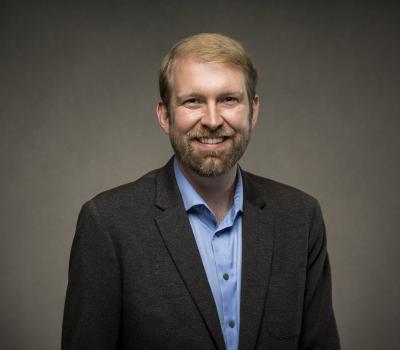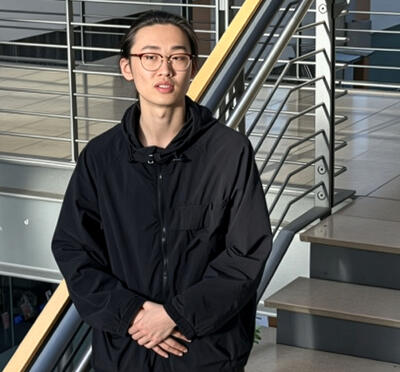Since he was a teenager growing up in Baker City, Oregon, Trevor Kent Howard has been determined to help save the world.
“One of the things I was most concerned about was climate change,” said Howard, who joined the College of Engineering in 2020, and was recently promoted to assistant professor of nuclear science and engineering. “I wanted to know how I could make the biggest difference with emerging technologies, such as wind, solar, hydroelectric, and nuclear.”
In high school, Howard started engaging with nuclear science on a theoretical level. He wrote reports on nuclear fusion in stars and tokamak reactors, convinced that fusion would be a promising carbon-neutral power source in the future. Still, with the exigencies of Earth’s climate crisis, he wondered what technologies could promote renewable energy more immediately. This led him to Oregon State University.
“For me, being interested in fusion at the time, it was physics or nuclear engineering. I chose the latter, as it was more applied,” Howard said. “As I progressed in my degree, I learned about upcoming reactor designs, like small modular reactors, passively-safe designs like the AP1000, and even Generation IV reactors that use liquid metals, molten salts, and very high-temperature gases. I knew the best way for me to make an impact was through nuclear fission.”
Howard, the first in his family to earn an advanced degree, holds the distinction of being a triple alumnus at Oregon State, earning his bachelor’s, master’s, and doctoral degrees in nuclear engineering here.
Continuing at Oregon State was an easy decision for Howard — with facilities such as the Multi- Application Small Light Water Reactor, a one-third scale model of NuScale’s small modular reactor; the High Temperature Test Facility, a one-quarter scale integral test facility model of the Modular High Temperature Gas Reactor; and the Hydro-Mechanical Fuel Test Facility, a test bed for high-performance research reactor fuel. The latter is why Howard took an interest in fluid-structure interactions (FSI), which occur when liquids or gases come in contact with solid structures. These phenomena became a focus of his graduate research and, eventually, his academic career.
“During my master’s, I was writing code that could solve FSI problems,” Howard said. “In reactors, where flow is fast, plates can start to bend, possibly, and break. My thesis focused on plate deflection in high-performance research reactors, which have plates and flow channels thinner than a dime, and water jetting through at 35 mph. If there’s any asymmetry, things could shift and move in ways you don’t want.”
While Howard’s master’s work was largely simulation-based, his doctoral research was more experimental, geared toward resonance in fluid dynamics.
“I was looking at how having two plates in tandem would affect the vortex shedding phenomena. For example, if I go down to the Willamette and poke it with a stick, the river won’t move across it symmetrically; it switches back and forth. This motion pushes the stick at a given frequency. If that frequency is just right, the stick moves more and more with every oscillation. This is resonance. Resonance can mean the difference between something working fine and something catastrophically failing,” Howard said. “Now, if I put a second stick downstream of the first, I’ll change the frequency of vortex-shedding if it’s close enough. You see the same thing with two plates that are lined up. One plate may be completely fine in your design, but adding a second may cause a huge problem.”
After earning his doctorate in 2018, Howard worked for two years at Oak Ridge National Laboratory as a thermal hydraulics research and development associate. He received a Mission Support Award in 2019 for his contributions to FSI work with the lab’s High Flux Isotope Reactor, the strongest reactor-based neutron source in the United States.
Howard’s main work was in the Energy Systems Development Group. The group houses the Liquid Salt Test Loop, a thermal hydraulic experiment designed to examine molten salt properties, as well as a solar salt loop to store heat for solar energy. He also assisted with simulations for a 3-D printed hydroelectric flume and worked on acoustic flow meter designs for the Transformational Challenge Reactor — a microreactor created via additive manufacturing.
For the past few years, Howard has been working with Wade Marcum and the Marcum Research Group to better address challenges associated with new and current nuclear reactor designs.
“There are some things about nuclear energy that many people don’t realize,” Howard said. “Nuclear has the potential to solve a lot of our climate and energy needs right now. For one, it’s very energy-dense, requiring only one uranium pellet the size of the upper knuckle of my pinkie to yield as much energy as 2,000 pounds of coal. Second, unlike other mined resources, uranium can be made renewable. The uranium cycle in the ocean is self-replenishing, and there’s enough to meet all our energy needs. In essence, nuclear power plants can be more renewable than wind and solar. These things are what fascinate me about nuclear energy. After all, I got into this business to help save the world.”




